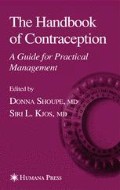Abstract
Emergency contraceptives (ECs) offer a “second chance” to prevent an unin-tended pregnancy. It is estimated that if the general population had better knowl-edge and easier access to ECs, their use could potentially cut the number of abortions performed each year in the United States in half. There are three major options available for emergency contraception: progestin-only pills (POPs), combination oral contraceptives (OCs), and insertion of an intrauterine device (IUD). Currently, there are 2 POPs and 18 combination pills (estrogen plus progestin) available that must be taken within 72 hours of unprotected sex according to treatment protocols listed in Table 1. The third option is insertion of a copper IUD within 5 days of unprotected sex. The progestin-only products, Plan B® and Ovrette®, are associated with less nausea than combined estrogen plus progestin EC products. Plan B is the only product designated and packaged as an EC.
Access this chapter
Tax calculation will be finalised at checkout
Purchases are for personal use only
Preview
Unable to display preview. Download preview PDF.
References
Salganicoff A, Wentworth B, Usha R. (2004) Emergency contraception in California. Kaiser Family Foundation report. Menlo Park, CA: Kaiser Family Foundation.
Drazen J, Greene M, Wood A. (2004) The FDA, politics, and Plan B. N Engl J Med 350:1561–1562.
Food and Drug Administration. FDA’s decision regarding Plan B: questions and answers. Available from: (http://www.fda.gov/cder/drug/infopage/planB/planBQandA.htm). Accessed March 10, 2006.
Croxatto HB, Devoto L, Durand M, et al. (2001) Mechanism of action of hormonal preparations used for emergency contraception: a review of the literature. Contraception 63:111–112.
Hapangama D, Glasier AF, Baird DT. (2001) The effects of peri-ovulatory administration of levonorgestrel on the menstrual cycle. Contraception 63:123–129.
Glasier A. (1997) Emergency postcoital contraception. N Engl J Med 337:1058–1064.
American College of Obstetricians and Gynecologists (ACOG). (2001) ACOG Committee on Practice Bulletins—gynecology. Emergency oral contraception. No. 25.
Ling WY, Robichaud A, Zayid I, Wrixon W, MacLeod SC. (1979) Mode of action of DL-norgestrel and ethinyl estradiol combination in postcoital contraception. Fertil Steril 32:297–302.
Alvarez F, Brache V, Fernandez E, et al. (1988) New insights on the mode of action of intrauterine contraceptive devices in women. Fertil Steril 49:768–773.
Rivera R, Yacobson I, Grimes D. (1999) The mechanism of action of hormonal contraceptives and intrauterine contraceptive devices. Am J Obstet Gynecol 181:1263–1269.
Piaggio G, von Hertzen H, Grimes DA, Van Look PF. (1999) Timing of emergency contraception with levonorgestrel or the Yuzpe regimen. Task Force on Postovulatory Methods of Fertility Regulation. Lancet 353:721.
Trussell J, Ellertson C, von Hertzen H, et al. (2003) Estimating the effectiveness of emergency contraceptive pills. Contraception 67:259–265.
Trussell J, Rodriquez G, Ellertson C. (1999) Updated estimates of the effectiveness of the Yuzpe regimen of emergency contraception. Contraception 59:147–151.
Women’s Capital Corporation. (1999) Plan B package insert; information for providers and clients. Washington, DC: Women’s Capital Corporation.
Zhou l, Xiao B. (2001) Emergency contraception with Multiload Cu-375 SL IUD: a multicenter clinical trial. Contraception 64:107–112.
Trussell J, Ellertson C. (1995) The efficacy of emergency contraception. Fertil Control Rev 4:8–11.
Pharmacy Access Partnership. Homepage. Available from: http://www.go2ec.org. Accessed March 10, 2006.
Raymond E, Creinin M, Barnhart K, Lovvorn A, Rountree R, Trussell J. (2000) Meclizine for prevention of nausea associated with use of emergency contraceptive pills: a randomized trial. Obstet Gynecol 95:271–277.
Glasier A, Baird D. (1998) The effects of self-administering emergency contraception. N Engl J Med 339:1–4.
Ellertson C, Ambardekar S, Hedley A, Coyaji K, Trussell J, Blanchard K. (2001) Emergency contraception: randomized comparison of advance provision and information only. Obstet Gynecol 98:570–575.
Stewart FH, Trussell J. (2000) Prevention of pregnancy resulting from rape; a neglected preventive health measure. Am J Prevent Med 19:228–229.
vonHertzen H, Piaggio G, Ding J, et al. (2002) Low dose mifepristone and two regimens of levonorgestrel for emergency contraception: a WHO multicentre randomized trial. Lancet 360:1803–1810.
Task Force on Postovulatory Methods of Fertility Regulation. (1998) Randomised controlled trial of levonorgestrel versus the Yuzpe regimen of combined oral contraceptives for emergenchy contraception. Lancet 352:428–433.
World Health Organization (WHO). (1998) Emergency contraception: a guide for service delivery. Geneva, Switzerland: WHO.
Nielsen CL, Miller L. (2000) Ectopic gestation following emergency contraceptive pill administration. Contraception 62:275–276.
Sheffer-Mimouni G. (2003) Ectopic pregnancies following emergency levonorgestrel contraception. Contraception 67:267–269.
Food and Drug Administration. (1997) Prescription drug products; certain combined oral contraceptives for use of postcoital emergency contraception. Federal Register: report no. 62:37.
Author information
Authors and Affiliations
Editor information
Editors and Affiliations
Rights and permissions
Copyright information
© 2006 Humana Press Inc., Totowa, NJ
About this chapter
Cite this chapter
Shoupe, D. (2006). Emergency Contraceptives. In: Shoupe, D., Kjos, S.L. (eds) The Handbook of Contraception. Current Clinical Practice. Humana Press. https://doi.org/10.1007/978-1-59745-150-5_12
Download citation
DOI: https://doi.org/10.1007/978-1-59745-150-5_12
Publisher Name: Humana Press
Print ISBN: 978-1-58829-599-6
Online ISBN: 978-1-59745-150-5
eBook Packages: MedicineMedicine (R0)

